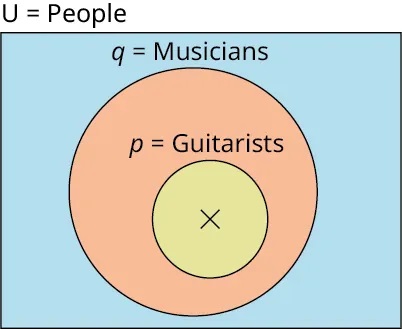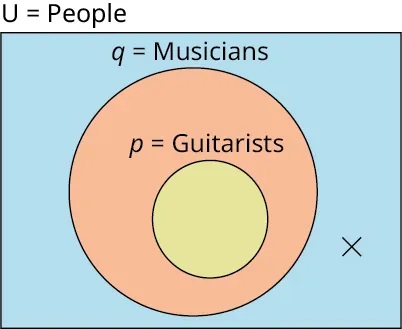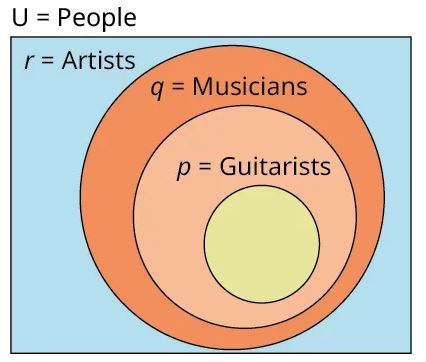Chapter 7 Logic
7.7 Logical Arguments
Learning Objectives
By the end of this section, you will be able to:
- Apply the law of detachment to determine the conclusion of a pair of statements
- Apply the law of denying the consequent to determine the conclusion for pairs of statements
- Apply the chain rule to determine valid conclusions for pairs of true statements
The previous sections of this chapter provide the foundational skills for constructing and analyzing logical arguments. All logical arguments include a set of premises that support a claim or conclusion; but not all logical arguments are valid and sound. A logical argument is valid if its conclusion follows from the premises, and it is sound if it is valid and all of its premises are true. A false or deceptive argument is called a fallacy. Many types of fallacies are so common that they have been named.
This section focuses on the two main forms that logical arguments can take. While inductive arguments attempt to draw a more general conclusion from a pattern of specific premises, deductive arguments attempt to draw specific conclusions from at least one or more general premises. Deductive arguments can be proven to be valid using Venn diagrams or truth tables.
Inductive arguments generally cannot be proven to be true. They are judged as being strong or weak, but like any opinion, whether you believe an argument is strong or weak often depends on your knowledge of the topic being discussed along with the evidence being provided in the premises. Hasty generalization is the name given to any fallacy that presents a weak inductive argument.
Be careful! Premises may be true or false. If a premise is false, the claims made by the argument should be questioned.
Law of Detachment
The law of detachment is a valid form of a conditional argument that asserts that if both the conditional, [latex]p \rightarrow q[/latex], and the hypothesis, [latex]p[/latex], are true, then the conclusion [latex]q[/latex] must also be true. The law of detachment is also called affirming the hypothesis (or antecedent) and modus ponens. Symbolically, it has the form [latex]((p \rightarrow q) \wedge p) \rightarrow q[/latex].
[latex]\begin{array} {|l l|} \hline \textbf{Law of detachment} & \\ \hline \text{Premise:} & p \rightarrow q\\ \hline \text{Premise:} & p\\ \hline \text{Conclusion:} & \therefore q \\ \hline \end{array}[/latex]
The [latex]\therefore[/latex] is read as the word “therefore.”
Looking at the truth table for the conditional statement, the only time the conditional is true is when the hypothesis [latex]p[/latex] is also true. The only place this happens is in the first row, where [latex]q[/latex] is also true, confirming that the law of detachment is a valid argument.
[latex]\begin{array} {|c|c|c|} \hline p & q & p \rightarrow q \\ \hline \text{T} & \text{T} & \textbf {T}\\ \hline \text{T} & \text{F} & \textbf {F}\\ \hline \text{F} & \text{T} & \textbf {T}\\ \hline \text{F} & \text{F} & \textbf {T}\\ \hline\end{array}[/latex]
Another way to verify that the law of detachment is a valid argument is to construct a truth table for the argument [latex]((p \rightarrow q) \wedge p) \rightarrow q[/latex] and verify that it is a tautology.
[latex]\begin{array} {|c|c|c|c|c|} \hline p & q & p \rightarrow q & (p \rightarrow q \wedge p & ((p \rightarrow q) \wedge p) \rightarrow q \\ \hline \text{T} & \text{T} & \text{T}& \text{T} & \textbf {T}\\ \hline \text{T} & \text{F} & \text{F} & \text{F} & \textbf {T}\\ \hline \text{F} & \text{T} & \text{T} & \text{F}& \textbf {T}\\ \hline \text{F} & \text{F} & \text{T}& \text{F} & \textbf {T}\\ \hline\end{array}[/latex]
Venn diagrams may also be used to verify deductive arguments, which include conditional premises. Consider the statement [latex]p \rightarrow q[/latex]: “If you play guitar, then you are a musician.” The set of guitarists is a subset of the set of musicians, [latex]p \subset q[/latex]. To verify that an argument is valid using a Venn diagram, draw the Venn diagram representing all the premises in the argument only, as shown in Figure 1. Then verify if the conclusion is also represented by the Venn diagram of the premises. If it is, the argument is valid. If it is not, the argument is not valid. The set of guitarists is drawn as a subset of the set of musicians to represent the premise, [latex]p \rightarrow q[/latex]. The [latex]\times[/latex] represents that the premise, [latex]p[/latex], is true. This completes the drawing of the premises.

Now examine the Venn diagram to verify if the conclusion is included in the picture. The conclusion is [latex]q[/latex].
Because the [latex]\times[/latex] is in the set [latex]p[/latex], and [latex]p[/latex] is a subset of [latex]q[/latex], [latex]\times[/latex] is also in [latex]q[/latex]; therefore, the law of detachment is a valid argument.
Remember that an argument can be valid without being true. For the argument to be proven true, it must be both valid and sound. An argument is sound if all its premises are true.
Video for Extra Help
Example 1
Each pair of statements represents the premises in a logical argument. Based on these premises, apply the law of detachment to determine a valid conclusion.
a) If Leonardo da Vinci was an artist, then he painted the Mona Lisa. Leonardo da Vinci was an artist.
The premises are [latex]p \rightarrow q[/latex]: Leonardo da Vinci was an artist, then he painted the Mona Lisa, and [latex]p[/latex]: Leonardo da Vinci was an artist. This argument has the form of the law of detachment, so the conclusion is [latex]q[/latex]: Leonardo da Vinci painted the Mona Lisa.
b) If Zion Williamson played for the New Orleans Pelicans, then Zion Williamson was not a soccer player. Zion Williamson played for the New Orleans Pelicans.
The premises follow the form of the law of detachment, so a valid conclusion would be [latex]q[/latex]: The premises are [latex]p \rightarrow q[/latex]: If Zion Williamson played for the New Orleans Pelicans, then Zion Williamson was not a soccer player, and [latex]p[/latex]: Zion Williamson played for the New Orleans Pelicans. The conclusion that follows from the premises is [latex]q[/latex]: Zion Williamson was not a soccer player.
c) If all fish have gills, then clown fish have gills. All fish have gills.
The premises are [latex]p \rightarrow q[/latex]: If all fish have gills, then clown fish have gills, and [latex]p[/latex]: All fish have gills. This argument has the form of the law of detachment, so the conclusion is [latex]q[/latex]: Clown fish have gills.
Exercise 1
Each pair of statements represents the premises in a logical argument. Based on these premises, apply the law of detachment to determine a valid conclusion.
a) If my classmate likes history, then some people like history. My classmate likes history.
b) If you do not like to read, then some people do not like reading. You do not like to read.
c) If the polygon has five sides, then it is not an octagon. The polygon has five sides.
Solution
a) Some people like history.
b) Some people do not like reading.
c) The polygon is not an octagon.
Law of Denying the Consequent
Another form of a valid conditional argument is called the law of denying the consequent, or modus tollens. Recall that the conditional statement [latex]p \rightarrow q[/latex] is logically equivalent to the contrapositive, [latex]\sim{q} \rightarrow \sim{p}[/latex]. So if the conditional statement is true, then the contrapositive statement is also true. By the law of detachment, if [latex]\sim{q}[/latex] is also true, then it follows that [latex]\sim{p}[/latex] must also be true. Symbolically, it has the form [latex]((p \rightarrow q)\wedge \sim{q}) \rightarrow \sim{p}[/latex].
[latex]\begin{array} {|l l|} \hline \textbf{Law of denying the consequent} & \\ \hline \text{Premise:} & p \rightarrow q\\ \hline \text{Premise:} & \sim{q} \\ \hline \text{Conclusion:} & \therefore \sim{p}\\ \hline \end{array}[/latex]
The conditional statement can also be described as “If antecedent, then consequent.” This is where the law of denying the consequent gets its name.
To verify if the law of denying the consequent is a valid argument, construct a truth table for the argument [latex]((p\rightarrow q)\wedge \sim{q}) \rightarrow \sim{p}[/latex] and verify that it is a tautology.
[latex]\begin{array} {|c|c|c|c|c|c|c|} \hline p & q &\sim{p}& \sim{q}& p \rightarrow q & (p \rightarrow q) \wedge \sim{q} & ((p \rightarrow q) \wedge \sim{q}) \rightarrow \sim{p} \\ \hline \text{T} & \text{T} & \text{F}& \text{F}& \text{T}& \text{F} & \textbf {T}\\ \hline \text{T} & \text{F} & \text{F}& \text{T}& \text{F} & \text{F} & \textbf {T}\\ \hline \text{F} & \text{T}& \text{T}& \text{F} & \text{T} & \text{F}& \textbf {T}\\ \hline \text{F} & \text{F} & \text{T}& \text{T}& \text{T}& \text{T} & \textbf {T}\\ \hline\end{array}[/latex]
To verify an argument of this form using a Venn diagram, again consider the premise: [latex]p \rightarrow q[/latex]: “If you play guitar, then you are a musician.” We will change the second premise to [latex]\sim{q}[/latex]. In this case, the [latex]\times[/latex] represents the premise [latex]\sim{q}[/latex]. So it will be placed inside the universal set of all people but outside the set of musicians, as depicted in the Venn diagram in Figure 2.

Because the [latex]\times[/latex] is also outside the set of guitarists, the statement [latex]\sim{p}[/latex] follows from the premises and the argument is valid.
Example 2
Each pair of statements represents the premises in a logical argument. Based on these premises, apply the law of denying the consequent to determine a valid conclusion.
a) If Leonardo da Vinci was an artist, then he painted the Mona Lisa. Leonardo da Vinci did not paint the Mona Lisa.
The premises are [latex]p \rightarrow q[/latex]: If Leonardo da Vinci was an artist, then he painted the Mona Lisa, and [latex]\sim{q}[/latex]: Leonardo da Vinci did not paint the Mona Lisa. This argument has the form of the law of denying the consequent, so the conclusion is [latex]\sim{p}[/latex]: Leonardo da Vinci was not an artist.
b) If Zion Williamson played for the New Orleans Pelicans, then Zion Williamson was not a soccer player. Zion Williamson was a soccer player.
The premises follow the form of the law of denying the consequent, so a valid conclusion would be [latex]\sim{p}[/latex]. The premises are [latex]p \rightarrow q[/latex]: If Zion Williamson played for the New Orleans Pelicans, then Zion Williamson was not a soccer player, and [latex]\sim{q}[/latex]: Zion Williamson was a soccer player. The conclusion that follows from the premises is [latex]\sim{p}[/latex]: Zion Williamson did not play for the New Orleans Pelicans.
c) If all fish have gills, then clown fish have gills. Clown fish do not have gills.
The premises are [latex]p \rightarrow q[/latex]: If all fish have gills, then clown fish have gills, and [latex]\sim{q}[/latex]: clown fish do not have gills. This argument has the form of the law of denying the consequent, so the conclusion is [latex]\sim{p}[/latex]: Some fish do not have gills.
Exercises 2
a) If my classmate likes history, then some people like history. Nobody likes history.
b) If Homer does not like to read, then some people do not like reading. All people like reading.
c) If the polygon has five sides, then it is not an octagon. The polygon is an octagon.
Solution
a) My classmate does not like history.
b) Homer likes to read.
c) The polygon does not have five sides.
Chain Rule for Conditional Arguments
The chain rule for conditional arguments is another form of a valid conditional argument. It is also called a hypothetical syllogism or the transitivity of implication. Recall that the conditional statement [latex]p \rightarrow q[/latex] can also be read as [latex]p[/latex] implies [latex]q[/latex]. This is where the name transitivity of implication comes from. The transitive property for numbers states that if [latex]3 \lt 4[/latex] and [latex]4 \lt 5[/latex], then it follows that [latex]3 \lt 5[/latex]. The chain rule extends this property to conditional statements. If the premises of the argument consist of two conditional statements with the form “[latex]p\rightarrow q[/latex]” and “[latex]q \rightarrow r[/latex],” then it follows that [latex]p \rightarrow r[/latex]. Symbolically, it has the form [latex]((p \rightarrow q) \wedge (q \rightarrow r)) \rightarrow (p \rightarrow r)[/latex].
[latex]\begin{array} {|l l|} \hline \textbf{Chain rule for conditional arguments} & \\ \hline \text{Premise:} & p \rightarrow q\\ \hline \text{Premise:} & q \rightarrow r\\ \hline \text{Conclusion:} & \therefore p \rightarrow r \\ \hline \end{array}[/latex]
To verify the chain rule for conditional arguments, construct a truth table for the argument [latex]((p \rightarrow q)\wedge (q \rightarrow r)) \rightarrow (p \rightarrow r)[/latex] and verify that it is a tautology.
[latex]\begin{array} {|c|c|c|c|c|c|c|c|} \hline p & q &r&p \rightarrow q & q \rightarrow r & (p \rightarrow q) \wedge (q \rightarrow r) & ((p \rightarrow r)&((p \rightarrow q) \wedge (q \rightarrow r)) \rightarrow (p \rightarrow r) \\ \hline \text{T} & \text{T} & \text{T} & \text{T}& \text{T}& \text{T}& \text{T} & \textbf {T}\\ \hline \text{T} & \text{T} & \text{F} & \text{T}& \text{F}& \text{F} & \text{F} & \textbf {T}\\ \hline \text{T} & \text{F}& \text{T}& \text{F} & \text{T} & \text{F} & \text{T}& \textbf {T}\\ \hline \text{T}& \text{F} & \text{F} & \text{F}& \text{T}& \text{F}& \text{F} & \textbf {T}\\ \hline \text{F}& \text{T} & \text{T} & \text{T}& \text{T}& \text{T}& \text{T} & \textbf {T}\\ \hline \text{F}& \text{T} & \text{F} & \text{T}& \text{F}& \text{F}& \text{T} & \textbf {T}\\ \hline \text{F}& \text{F} & \text{T} & \text{T}& \text{T}& \text{T}& \text{T} & \textbf {T}\\ \hline \text{F}& \text{F} & \text{F} & \text{T}&\text{T}& \text{T}& \text{T} & \textbf {T}\\ \hline \end{array}[/latex]
To verify an argument of this form using a Venn diagram, again consider the premise [latex]p \rightarrow q[/latex]: “If you play guitar, then you are a musician,” but change the second premise to [latex]q \rightarrow r[/latex]: “If you are a musician, then you are an artist.” In this case, the set [latex]p[/latex] of guitarists is a subset of the set [latex]r[/latex] artists, and it follows that if you are a guitarist, then you are an artist. Therefore, the conclusion [latex]p \rightarrow r[/latex] follows from the premises, and the chain rule for logical arguments is valid. See Figure 3.

Example 3
Applying the Chain Rule for Conditional Arguments to Determine a Valid and Sound Conclusion
Each pair of statements represents true premises in a logical argument. Based on these premises, apply the chain rule for conditional arguments to determine a valid and sound conclusion.
a) If my roommate goes to work, then my roommate will get paid. If my roommate gets paid, then my roommate will pay their bills.
The premises are [latex]p \rightarrow q[/latex]: “If my roommate goes to work, then they will get paid,” and [latex]q \rightarrow r[/latex]: “If my roommate gets paid, then my roommate will pay their bills.” This argument has the form of the chain rule for conditional arguments, so the valid conclusion will have the form “[latex]p \rightarrow r[/latex].” Because all the premises are true, the valid and sound conclusion of this argument is: “If my roommate goes to work, then my roommate will pay their bills.”
b) If robins can fly, then some birds can fly. If some birds can fly, then we will watch birds fly.
The premises are [latex]p \rightarrow q[/latex]: “If robins can fly, then some birds can fly,” and [latex]q \rightarrow r[/latex]: “If some birds can fly, then we will watch them fly.” This argument has the form of the chain rule for conditional arguments, so the valid conclusion will have the form: “[latex]p \rightarrow r[/latex].” Because all the premises are true, the valid and sound conclusion of this argument is “If robins can fly, then we will watch birds fly.”
c) If Irma is a teacher, then Irma has a college degree. If Irma has a college degree, then Irma graduated from college.
The premises are [latex]p \rightarrow q[/latex]: (see line 1 of Solution 1 and 2 above) “If Irma is a teacher, then Irma has a college degree,” and [latex]q \rightarrow r[/latex]: “If Irma has a college degree, then Irma graduated from college.” This argument has the form of the chain rule for conditional arguments, so the valid conclusion will have the form “[latex]p \rightarrow r[/latex].” Because all the premises are true, the valid and sound conclusion of this argument is “If Irma is a teacher, then Irma graduated from college.”
Exercise 3
Each pair of statements represents true premises in a logical argument. Based on these premises, apply the chain rule for conditional arguments to determine a valid and sound conclusion.
a) If my roommate does not go to work, then my roommate will not get paid. If my roommate does not get paid, then they will not be able to pay their bills.
b) If penguins cannot fly, then some birds cannot fly. If some birds cannot fly, then we will watch the news.
c) If Marcy goes to the movies, then Marcy will buy popcorn. If Marcy buys popcorn, then she will buy water.
Solution
a) If my roommate does not go to work, then they will not be able to pay their bills.
b) If penguins cannot fly, then we will watch the news.
c) If Marcy goes to the movies, then she will buy water.
Media Attributions
- Figure 7.7.1 © OpenStax is licensed under a CC BY (Attribution) license
- Figure 7.7.2 © OpenStax is licensed under a CC BY (Attribution) license
- Figure 7.7.3 © OpenStax Contemporary Mathematics is licensed under a CC BY (Attribution) license
A logical argument is valid if its conclusion follows from the premises.
A logical argument is sound if it is valid and all of its premises are true.
A false or deceptive argument.
Deductive arguments attempt to draw specific conclusions from at least one or more general premises.
The name given to any fallacy that presents a weak inductive argument.
A valid form of a conditional argument that asserts that if both the conditional, [latex]p \rightarrow q[/latex], and the hypothesis, [latex]p[/latex], are true, then the conclusion [latex]q[/latex] must also be true.

